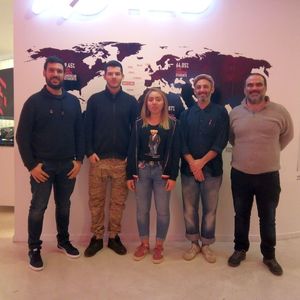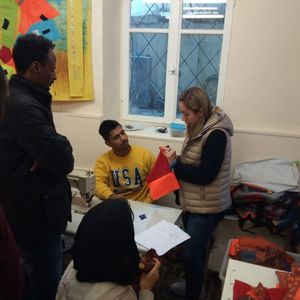Refugees in Lesbos: Connecting past, present and future
| Subject: International Cooperation
Follow-up on the life jacket recycling project

A delegation from the AMB recently travelled to the Greek island of Lesbos to monitor the project "Refugees in Lesbos: Connecting past, present and future", which the AMB is currently developing with the local entity Lesvos Solidarity. The team was composed by 2 students from IED Barcelona school, Gabriela Serrano and Vittorio Lombardo, winners of the social ideas life jacket recycling contest held last spring, and teacher Aviv Shany.
The aim of the project is, on the one hand, to raise awareness of the environmental protection and to reinforce good practices, in an area which includes the Lesvos Solidarity life jacket recycling workshop, and, on the other hand, to create a refugee memorial to foster recognition and a raise critical thinking of the refugee crisis in Lesbos.
During the visit, the winners of the social ideas contest presented their winning proposal to the team at Lesvos Solidarity, who worked with them to adjust their pattern for production in the workshop, and gained a first-hand look at the reality of the refugee situation on the island of Lesbos.
During the first day of the visit included a working session in Lesvos Solidarity's Mosaik Centre, a refugee care centre that organises creative and productive activities, cultural events and recycling projects aimed at increasing social cohesion between the local community and refugees. The centre has a workshop for manufacturing products from life jackets and a small shop in which they are sold. The most unique and valuable aspect of these projects is the fact the refugees are involved in every step of the life jacket recycling process, from cleaning them to designing the patterns for the objects. The team also had the opportunity to visit the Pipka Camp, which is run by Lesvos Solidarity and hosts 100 particularly vulnerable refugees.
The second day of the visit helped to shed light on the reality of the refugee situation on the island of Lesbos, on which the close to 22,000 refugees currently living in poor conditions are working to improve their own living conditions and speed up the asylum process. The team also visited the Moria Camp, the Greek government's official refugee camp, which, despite its 2,500-person capacity, is currently home to over 6,000 refugees, in addition to the 13,000 refugees who reside in the immense informal camp that has sprung up around the official camp. Here, the envoys were introduced to the education and art project administered and controlled by refugees from the camp. The team was then taken to the life jacket graveyard in Mithymna, in the north of the island. A highly symbolic site, it is the final resting place for the objects that have saved thousands of lives, but whose presence has become an affront to environmental sustainability, as well as the source of the life jacket recycling process. This landfill provides the life jackets that, once cleaned, are used in the Lesvos Solidarity life jacket recycling workshop.
The last stop was Skala Sykamnia, a village 9 km from the Turkish coast, which is a major landing site for refugees. Here, members of the AMB's Cooperation team and Lesvos Solidarity met with the town Mayor to follow up on the project to create a refugee memorial on Lesbos.
Image gallery
Related documents
Related links
Where















































